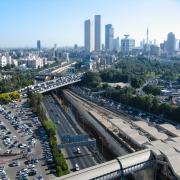Reflectance Spectroscopy as a Rapid Tool for Quantitative Mapping of Hydrocarbons Soil Contamination
הסטודנט: גיא שוורץ
מנחה: פרופ' אייל בן דור ודר' גיל אשל
עבודת גמר לדוקטורט
הסטודנט: גיא שוורץ
מנחה: פרופ' אייל בן דור ודר' גיל אשל
עבודת גמר לדוקטורט
Soil reflectance spectroscopy is a well known technique to assess soil properties rapidly and quantitatively both in point (Spectroscopy) and image (Imaging Spectroscopy (IS)) domains. The quantitative approach has been developed in the past two decades by many researchers and many papers have been published on this subject in the scientific literature. Basically, the quantitative approach has been adopted from other disciplines (e.g. food, textile, pharmaceutical); whereas the mapping approach has been developed by incorporating spectroscopy with remote sensing means (IS).
Soil contamination is an ever-growing concern. There is a great need for an objective, environmental friendly method to rapidly detect and monitor soil contaminants, both for the diagnosis of suspected contaminated areas, as well as controlling rehabilitation processes. Conventional methods for investigating soil contamination based on point sampling and chemical analysis are time consuming, relatively expensive and sometimes incorporate the use of non environmental-friendly chemicals. Using soil reflectance spectroscopy, several direct and indirect soil properties as well as soil contamination characteristics can be extracted and monitored efficiently.
Due to the vast amount of data in soil spectroscopy, either for point or image, data mining processes are needed. In this study we present the soil spectroscopy theory and its quantitative capabilities as well as the data mining methods of the soil spectra that are related to soil contamination. The contaminants that shall be inspected include petroleum hydrocarbons, heavy metals, acid mine drainage, pesticides, and vegetation stress as an indicator for soil contamination. We are reviewing all work done to assess these contaminations in soil either by spectroscopy or IS methods with a special emphasis on petroleum hydrocarbons contaminations.
The traditional chemistry based determination process of measuring petroleum hydrocarbons contamination in soil samples, and the process’s possible biases are discussed.
A new chemometric analysis approach of reflectance spectroscopy data is suggested, alongside with a new statistical parameter for model performance evaluation. This approach is general and can work with any near infrared dataset automatically and optimally. We tested this tool by creating chemometric models based on laboratory prepared petroleum contaminated soil samples, and thereafter these reflectance spectroscopy chemometric models were used to map the petroleum hydrocarbons contamination spread of a contaminated site with high accuracy. Based on laboratory prepared samples, modeling performance results ranged with average RPD of 4 to over 20 and MPS of 100 to over 180. The division of a dataset into training, validation and test groups does affect the modeling process to some extent and different preprocessing methods or their combinations needs to be selected based on soil type and PHC type. In the field a high correlation was found between the predicted values and the values measured in the laboratory (R2>0.9). This high correlation enables the creation of accurate contamination contour maps of the contamination spread, helping tremendously in the site investigation and remediation process.
Furthermore, limitation, obstacles and problems in measuring soil spectroscopy in the field and in the laboratory are discussed, and this discussion is elaborate to the IS technology. In this regard the problems (and possible solutions) to use IS for mapping soil contamination from a-far (sensors, optics, atmosphere attenuation, sensor platform, quality indicators etc.) are discussed, and some light is shed on the current and future IS missions to that end. The spectral approach accuracy was compared with traditional well-known methods and commercially certified laboratories performances were evaluated. We found that the spectral approach combined with the data mining system developed especially for this work performs as good as the traditional high cost methods at the evaluated certified laboratories, in some cases it even preformed better. To conclude, a roadmap is sketched for the future potential of spectral technology to be used in soil contamination monitoring, based on the ongoing initiatives that are taking place worldwide (e.g. placing IS in orbit, new IS airborne sensors and new generation of portable spectrometers).



